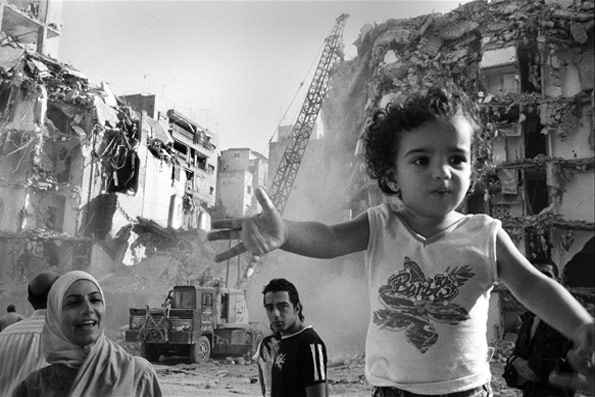Lebanon | Rania Matar: The Forgotten
“Girl in the Light,” Rania Matar, 2005
By Grace Aneiza Ali
“This is not a political project,” says Beirut-born photographer Rania Matar (www.raniamatar.com) about her work to document the aftermath of Lebanon’s civil war and the conditions in the country’s Palestinian refugee camps. “It does not try to promote any solution to a complicated and sensitive issue, but is a photographic portrait of a forgotten people in search of a home.” Matar’s work, captured in her stunning debut monograph, Ordinary Lives, (Quantuck Lane Press, 2009) may not be intended as a political project, but at its core, it is a compassion project.
 Fatima (pictured) aptly named the “Girl in the Light,” lives in the Bourj El Shamali camp for Palestinian refugees, one of the poorest in Lebanon. Matar was immediately drawn to Fatima because of her “dream-filled eyes.” Fatima lives in a barren corrugated metal house. There is one window. On the ground are futons that serve as beds. You know a family lives here because of the laundry hanging from the walls. Matar’s lens capture a girl living in her own world. Her face and body are unscathed against the harsh concrete wall she leans on. She is unmoved by the rubble, undeniable markers of war and violence, outside those walls.
Fatima (pictured) aptly named the “Girl in the Light,” lives in the Bourj El Shamali camp for Palestinian refugees, one of the poorest in Lebanon. Matar was immediately drawn to Fatima because of her “dream-filled eyes.” Fatima lives in a barren corrugated metal house. There is one window. On the ground are futons that serve as beds. You know a family lives here because of the laundry hanging from the walls. Matar’s lens capture a girl living in her own world. Her face and body are unscathed against the harsh concrete wall she leans on. She is unmoved by the rubble, undeniable markers of war and violence, outside those walls.
Matar, who grew up in Lebanon during the civil war, is drawn to the Palestinian refugee camps around Lebanon because she sees a universal message of resilience and hope there. “I find inspiration in people struggling to keep their roots, spirit, and culture alive,” she says. “And in their incredible capacity to adapt and make the best of their circumstances so they can preserve their dignity, their hope, and their humanity.”
 Her point of view, one in which the physical circumstances, at times dire, are treated as secondary, is a running thread through Matar’s work. Her lens instead gravitate towards symbolic points of light—like that of a mother’s joy as she watches her toddler at play. In “Barbie Girl,” (Haret Hreik Beirut 2006), one does not miss that the backdrop of the toddler’s playground is outlined by hollowed-out bombed buildings to the left and right. But the remnants of war and the presence of mass destruction are supporting characters in a narrative where, for Matar, mother and child are the leading actors.
Her point of view, one in which the physical circumstances, at times dire, are treated as secondary, is a running thread through Matar’s work. Her lens instead gravitate towards symbolic points of light—like that of a mother’s joy as she watches her toddler at play. In “Barbie Girl,” (Haret Hreik Beirut 2006), one does not miss that the backdrop of the toddler’s playground is outlined by hollowed-out bombed buildings to the left and right. But the remnants of war and the presence of mass destruction are supporting characters in a narrative where, for Matar, mother and child are the leading actors.
Despite the title of Matar’s monograph, there is nothing ordinary about the lives she captures on film. Instead, Matar’s images poignantly remind us that we are not our circumstances—a feat that speaks to the extraordinary spirit of her subjects and to her values as a photographer.
Rania Matar’s series “The Forgotten People” was featured in the Spring 2009 edition of Nueva Luz Photographic Journal, published by En Foco, a non-profit organization that nurtures and supports photographers of diverse cultures.

